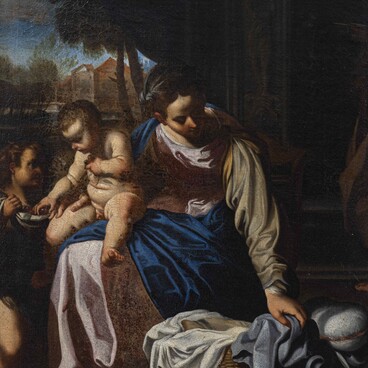Alexander Adriansen, a Flemish painter, master of still life and engraver, was born in Antwerp at the end of the 16th century. His father was a composer and both of his brothers were painters. So from the age of ten, the boy also began to train in art with one of the local artists. At the age of twenty-three, he became a professional artist, joining the guild of painters as a watercolorist and later as a painter.
The main genre Adriansen worked in was still life. Popular both in Flemish and Dutch art of the 17th century, it had numerous common themes: “kitchen” and “luxury”, “hunting” and “flower”, “fish stall” and “set table”, vanitas (depicting the frailty of existence), “monochrome breakfast”, etc. The main difference was the approach to the interpretation of the subjects. Unlike Flemish art which celebrated the riches of nature with joy and gratitude, Dutch art focused on edifying and allegorical subtexts, even in domestic scenes and still lifes.
Adriansen’s canvases were not overly spectacular, but their modesty and simplicity contributed to the accurate and natural portrayal of objects. He painted small pieces composed of plants, birds, fish, vases, silver vessels, and fruit. He also painted “flower garlands” for the works of other artists.
“Fish” by Adriansen can be classified as both a “fish shop” and a “kitchen” still life: seafood and salmon dripping with water, laid out on the table to be cooked, are already partially processed, as if the cook has been distracted for a moment. But it could be a fragment of a fishmonger’s shop: his proximity to the sea gave the artist an opportunity to depict the most diverse “inhabitants of the depths” and turn his still life into an illustration of nature’s abundance, his glorification of fishing work.
Adriansen’s fish still lifes are rather monotonous. They have a simple, horizontally unfolded composition, a generally neutral brown background; the seafood is laid out on wooden tabletops. Deprived of luxury and intense colors, they attract the eye with softened contrasts of light and shade, occasional bright spots of fish flesh, the shine of wet scales and sparkling droplets of water. The realistic manner of depiction was appreciated by the artist’s contemporaries. His 170 works are signed, of which the last one dates back to 1660.
The main genre Adriansen worked in was still life. Popular both in Flemish and Dutch art of the 17th century, it had numerous common themes: “kitchen” and “luxury”, “hunting” and “flower”, “fish stall” and “set table”, vanitas (depicting the frailty of existence), “monochrome breakfast”, etc. The main difference was the approach to the interpretation of the subjects. Unlike Flemish art which celebrated the riches of nature with joy and gratitude, Dutch art focused on edifying and allegorical subtexts, even in domestic scenes and still lifes.
Adriansen’s canvases were not overly spectacular, but their modesty and simplicity contributed to the accurate and natural portrayal of objects. He painted small pieces composed of plants, birds, fish, vases, silver vessels, and fruit. He also painted “flower garlands” for the works of other artists.
“Fish” by Adriansen can be classified as both a “fish shop” and a “kitchen” still life: seafood and salmon dripping with water, laid out on the table to be cooked, are already partially processed, as if the cook has been distracted for a moment. But it could be a fragment of a fishmonger’s shop: his proximity to the sea gave the artist an opportunity to depict the most diverse “inhabitants of the depths” and turn his still life into an illustration of nature’s abundance, his glorification of fishing work.
Adriansen’s fish still lifes are rather monotonous. They have a simple, horizontally unfolded composition, a generally neutral brown background; the seafood is laid out on wooden tabletops. Deprived of luxury and intense colors, they attract the eye with softened contrasts of light and shade, occasional bright spots of fish flesh, the shine of wet scales and sparkling droplets of water. The realistic manner of depiction was appreciated by the artist’s contemporaries. His 170 works are signed, of which the last one dates back to 1660.


